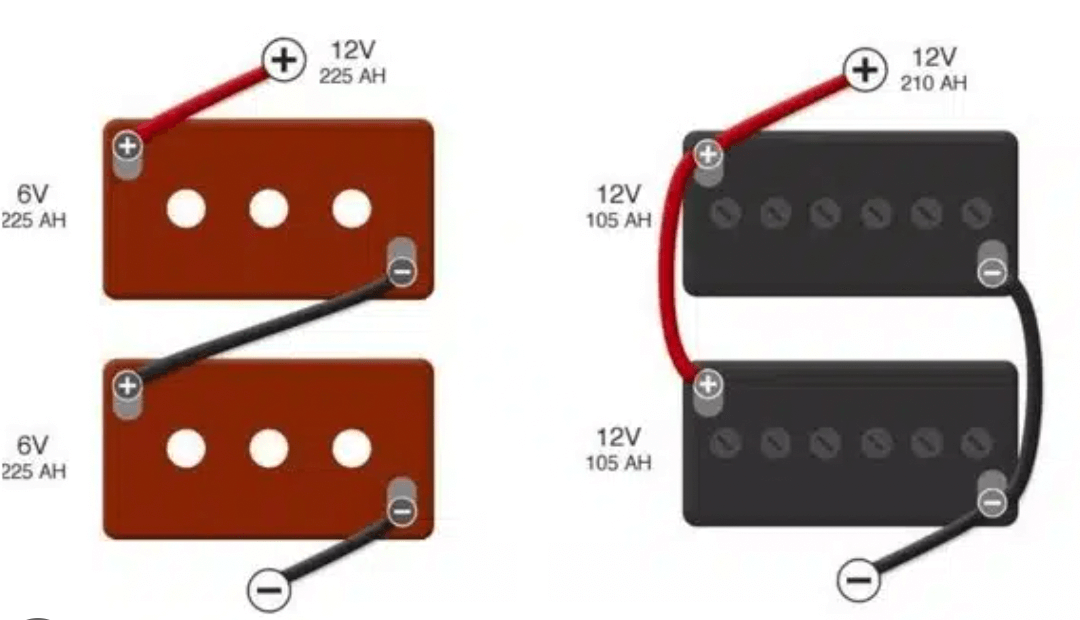As someone who has worked with solar energy systems for years, one of the most common questions I get is, “Should I connect my solar batteries in series or in parallel?”
At first glance, both setups might seem similar. You’re just linking batteries together, right? But how you wire your batteries dramatically affects voltage, current, system performance, and even efficiency.
Understanding the difference between wiring solar batteries in series vs. parallel can help you avoid expensive mistakes and design a system that truly fits your needs.
What’s the Real Difference Between Batteries in Series and Parallel?
When you connect batteries in series, you’re increasing voltage. When you connect them in parallel, you’re increasing capacity (amp-hours).
Here’s how it works:
- Series wiring adds up the voltage of each battery while keeping the same capacity.
- Parallel wiring keeps the same voltage but adds up the amp-hour capacity.
For example, if I connect two 12-volt 100 Ah batteries in series, I’ll get 24 volts at 100 Ah.
If I wire those same batteries in parallel, I’ll get 12 volts at 200 Ah.
Interestingly, both configurations provide the same total energy:
12 V × 200 Ah = 24 V × 100 Ah = 2400 watt-hours.
That means neither setup gives you more energy. It’s just distributed differently. The key is matching your battery configuration to your system’s voltage and power needs.
How I Wire Solar Batteries in Series
When I need higher voltage, for example, for a 24 V or 48 V inverter system, I wire batteries in series. It’s straightforward:
- Connect the positive terminal of one battery to the negative terminal of the next.
- Measure the total voltage across the first negative terminal and the last positive terminal.
For instance:
- Two 12 V 100 Ah batteries in series = 24 V, 100 Ah
- Three 12 V 100 Ah batteries in series = 36 V, 100 Ah
Advantages of Series Wiring
There are several reasons I prefer series wiring for larger solar setups:
Higher voltage = lower current
A device drawing 360 watts at 12 V needs 30 amps, but only 15 amps at 24 V.
Lower current means thinner cables, less heat, and minimal voltage drop.
Greater efficiency
Many MPPT solar charge controllers work more efficiently at higher voltages.
For example, a 50 A controller handles 600 W at 12 V but 1200 W at 24 V.
Disadvantages of Series Wiring
The biggest drawback?
You can’t easily tap into lower voltages without a DC-DC converter. All your devices must match the system voltage. If your system runs at 24 V, you can’t directly power 12 V lights or appliances without conversion.
How I Wire Solar Batteries in Parallel
If I’m working on a small RV, camper, or off-grid cabin that runs on 12 volts, I use parallel wiring.
To wire batteries in parallel:
- Connect all positive terminals together.
- Connect all negative terminals together.
That’s it. You’ll maintain the same voltage, but your capacity (and therefore runtime) increases.
For example:
- Two 12 V 100 Ah batteries in parallel = 12 V, 200 Ah
- Three 12 V 100 Ah batteries in parallel = 12 V, 300 Ah
Advantages of Parallel Wiring
Longer runtime at the same voltage
Perfect for 12 V systems like RVs or boats.
Redundancy
If one battery fails, the others keep supplying power. This provides a level of reliability that’s great for mobile or backup power setups.
Disadvantages of Parallel Wiring
Parallel setups carry more current at lower voltage.
Higher current means thicker cables, more copper loss, and a greater risk of voltage drop.
For larger solar power systems (over 3 kW), parallel setups become less efficient and harder to manage safely.
How Many Batteries Can I Wire in Series?
That depends on the battery manufacturer.
For example, Battle Born lithium batteries allow up to four batteries in series, giving you 48 V total. Always check the specs. Exceeding manufacturer limits can cause damage or void your warranty.
How Many Batteries Can I Wire in Parallel?
Technically, there’s no limit, but practically, the more you add, the more complex the system becomes.
You’ll need:
- Thicker cables
- Proper fusing and protection for each battery
- Longer charging times
With large parallel banks, the available current can be dangerously high. I always use individual fuses on each battery to prevent catastrophic short circuits.
Can I Combine Series and Parallel Connections?
Yes, but carefully.
You can wire sets of batteries in series and then connect those sets in parallel.
For example:
- Two 12 V batteries in series = 24 V
- Two more in series = another 24 V set
- Now connect those two 24 V sets in parallel → you get a 24 V system with doubled capacity.
Think of each pair of series batteries as a single “unit.”
Just never mix and match random batteries of different ages, voltages, or capacities—it can lead to imbalance and premature failure.
Charging Solar Batteries in Series vs. Parallel
Charging methods differ slightly between the two configurations:
For series connections
Connect the charger’s positive lead to the first battery’s positive terminal and the negative lead to the last battery’s negative terminal.
For parallel connections:
Also connect the charger to opposite ends of the bank (positive on the first battery, negative on the last). This ensures even charging across all batteries.
If you want faster, more balanced charging, consider using a multi-bank smart charger designed for solar or lithium systems.
Do Batteries Last Longer in Series or Parallel?
In my experience, batteries in series tend to be slightly more efficient, mainly because they operate at higher voltage with lower current. However, both configurations deliver roughly the same total runtime if your load (wattage) stays constant.
Here’s a quick comparison:
Series setup
Two 12 V 100 Ah batteries = 24 V, 100 Ah → powers a 240 W load for ~10 hours.
Parallel setup
Two 12 V 100 Ah batteries = 12 V, 200 Ah → powers the same 240 W load for ~10 hours.
So the total usable energy is the same. It’s just delivered differently.
So, Which Is Better: Series or Parallel?
It depends entirely on your setup.
Choose series wiring if you’re running large inverters or high-power appliances or want to minimize current and cable size.
Choose parallel wiring if you’re running a 12 V system and need longer runtime or battery redundancy.
Personally, for solar installations above 1000 watts, I prefer wiring solar batteries in series to achieve higher system voltage.
It’s cleaner, safer, and more efficient. For smaller setups like RVs or boats, parallel wiring makes more sense.
Key Takeaways
- Series = higher voltage, same capacity.
- Parallel = same voltage, higher capacity.
- Both provide equal total energy (watt-hours).
- Series wiring is ideal for large solar systems.
- Parallel wiring is ideal for low-voltage, long-runtime setups.
- Always match batteries by brand, type, voltage, and age.
Final Thoughts
Understanding how to wire solar batteries in series vs. parallel is one of the most valuable lessons I’ve learned in my years working with solar energy systems.
Whether you’re powering a remote cabin, a camper, or a full off-grid home, the way you connect your batteries can make or break your system’s performance.
Take the time to plan it right. Your cables, controllers, and batteries will thank you later.

